Story and Artifacts
of Silla Kingdom
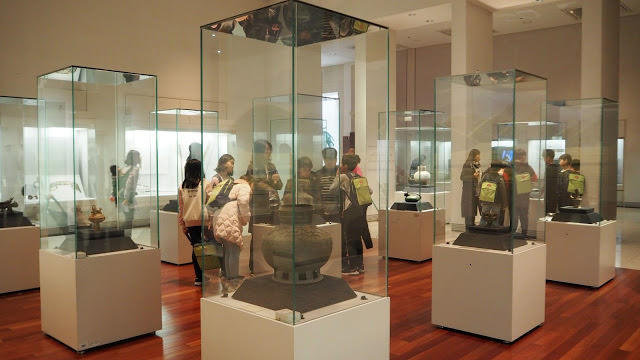 Story and Artifacts of Silla Kingdom [Exhibition Hall at the National Museum of Korea]
Story and Artifacts of Silla Kingdom [Exhibition Hall at the National Museum of Korea]Silla Kingdom Period (57 BC~935 AD)
The Three-Kingdoms Period - Silla
The Story and Artifacts of Silla Kingdom article briefly describes one of the exciting periods in Korean history. I am proud to introduce to you briefly some of Silla's stories, significant events, and achievements during its period.
I describe the Silla Kingdom not only in words but also through the photos I took from South Korea's national museum located in Seoul during my visit there.
Silla Kingdom existed from around 57 BC to 935 AD. It dominated the southern and central parts of the old Korean Peninsula.
Silla was among the three, along with Baekje and Goguryeo, that made up the famous Three Kingdoms of Korea.
The Kingdom was founded by Hyeokgyeose of Silla of the Park family. The Silla Dynasty was ruled by Gyeongju Kim clan for 586 years, Miryang Park clan for 232 years, and Wolseong Seok clan form 172 years.
 Donggung Palace & Wolji Pond in Gyeongju
Donggung Palace & Wolji Pond in GyeongjuSignificant features and achievements of the Silla Kingdom include...
- it defeated Baekje in 660 and Goguryeo in 668
- had a detailed system of law and governance, social status and official advancement
- had a rigid lineage-based system
- early Silla had royal guards who also served as a military force
- royal tombs of Silla can be found in Gyeongju City up to this day as attractions
- Silla kings adopted Buddhism, which is reflected in temples, stone figures, carvings, etc.
Now, let me describe a bit more about the Kingdom with photos below.
Story and Artifacts of Silla Kingdom
 Story and Artifacts of Silla Kingdom - Stone Foundations
Story and Artifacts of Silla Kingdom - Stone Foundations Ruins rocks foundation
Ruins rocks foundation Pillars Stone Foundation
Pillars Stone Foundation Rock Foundations
Rock FoundationsEstablishing Silla Kingdom
Silla evolved from Saro, a walled town in present-day Gyeongju. Silla established its ideological and political foundation with the introduction of Buddhism and the administrative code.
Culturally, Silla achieved its own styles, as is evident in the wooden chamber tombs with stone and earthen mounds, its pottery featuring shapely lines, and the gold crowns with unique upright ornaments.
A variety of glassware and other funerary objects of foreign origin attest to the cosmopolitan aspect of Silla culture.
Silla Weaponry
The Silla weapons were excavated so far can be divided into two categories, those for offenses such as socketed spearheads, swords, and arrowheads, and those for the defense such as suits of armor and helmets.
One of the most outstanding relics from this period is a sword with a ring pommel lavishly decorated with gold and silver.
The sword, which has a long socketed blade, is believed to have served as a symbol of its owner's political authority.
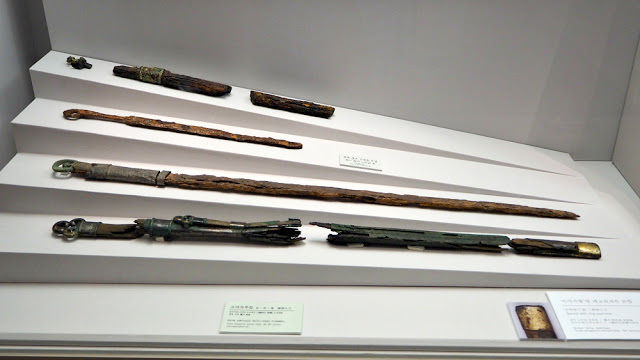 Excavated swords produced during the Sill Kingdom Period
Excavated swords produced during the Sill Kingdom Period Statues and Foundations
Statues and Foundations Buddhist influence on Silla Kingdom
Buddhist influence on Silla Kingdom Equipment for the Horse
There were various kinds of weapons and horse equipment excavated from Silla tombs. Weapons include swords, arrowheads, socketed spearheads, armor, and helmets.
Trappings include saddles, stirrups, bits, horse bells, and other ornamental furnishings.
Weaponry and pieces of equipment exquisitely decorated with gold or silver attest to the excellence of Silla craftsmanship as well as the social status of the deceased.
Tombs of Silla
The outer coffin tombs with stone and earthen mounds characterize Silla burial practice, by which first the outer coffin was prepared in a pit or on the ground.
The inner coffin and funerary objects were placed into the outer coffin, after which stone pebbles were piled on the sides and top of the coffin, which was then covered with an earthen mound.
The extravagance of the burial itself and the dazzling variety of attendant goods, including gold crowns symbolize the power and wealth of Silla.
Decorations of Silla Pottery
Many Silla earthenware vessels are decorated with incised patterns, pendants, and clay figurines.
Some vessels possess a surface covered with impressed patterns that were made by the tools used to beat and harden them.
The patterns are diverse, ranging from geometric patterns to concrete forms such as animals and human figures.
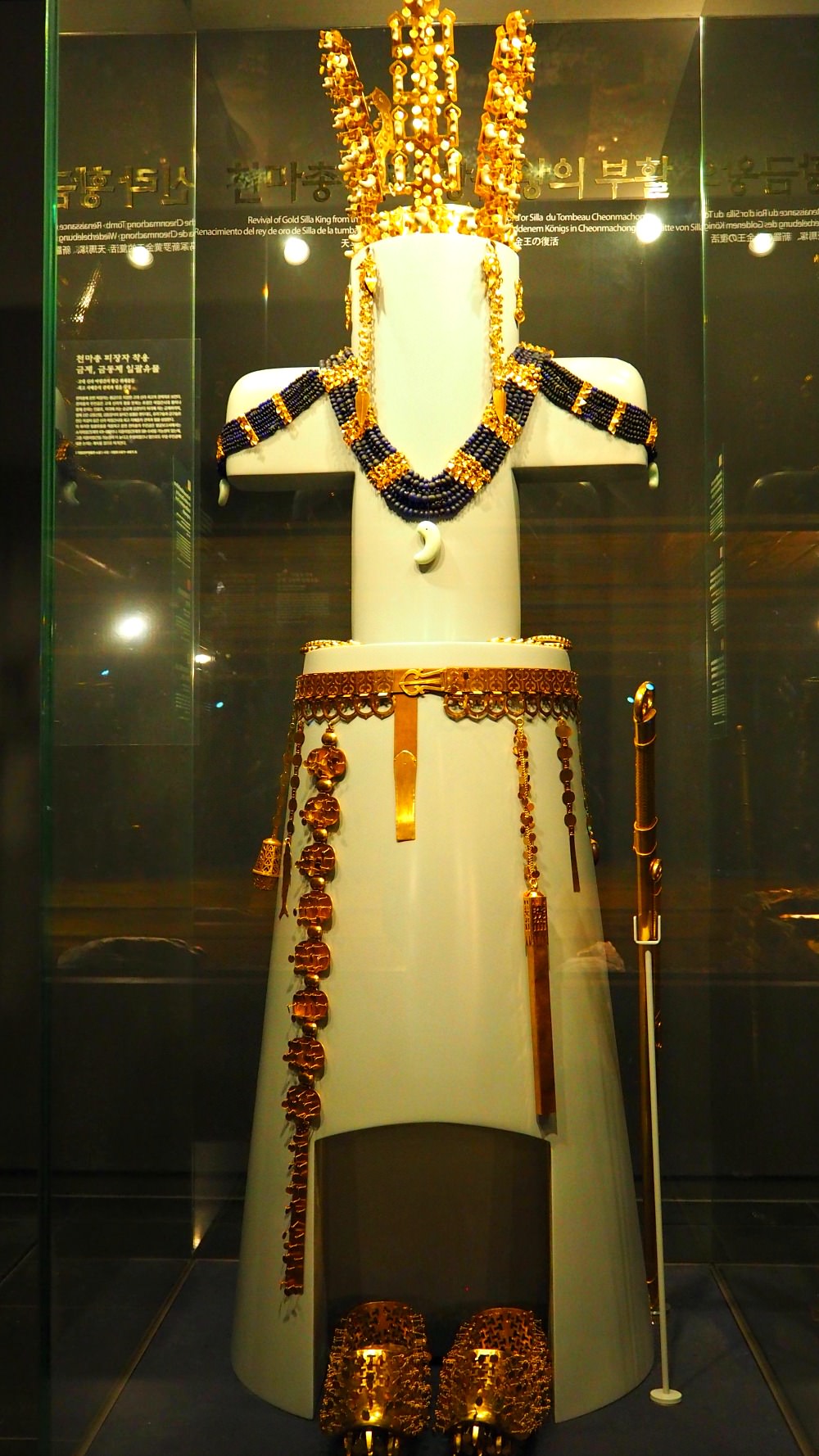 Gold Crown & Girdle
Gold Crown & GirdleGold Crown and Girdle
The photo is a gold crown with ornamentation in the form of tree branches and deer antlers attached along with the headband.
The gold crown is designed to express the sovereignty of the king, The identity, and worldview of the royal family.
The
gold waist belt is composed of a buckle, belt-end ornaments,
accessories for leather or silk-made straps, and waist pendants.
These pendants include fish-shaped pendants, miniature knife, and curved jades that seem to represent household tools.
Horse and Rider-shaped Vessel
Three-Kingdoms period (Silla), 6th century
Geumnyeongchong, Gyeongju, Gyeongsang-do
This vessel is shaped like a rider on horseback, wearing a headband and carrying some cargo on his back.
The bell in his right hand would seem to indicate that he is a servant leading the spirit of his deceased master into the afterlife
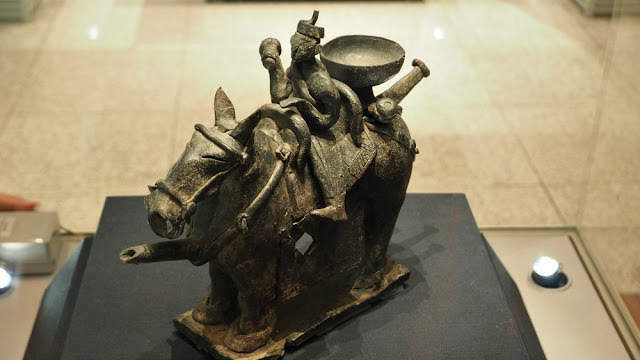 Horse and Rider-shaped Vessel
Three-Kingdoms period (Silla), 6th century
Geumnyeongchong, Gyeongju, Gyeongsang-do
Horse and Rider-shaped Vessel
Three-Kingdoms period (Silla), 6th century
Geumnyeongchong, Gyeongju, Gyeongsang-doPhoenix-Shaped Glass Vessel (below)
Three-Kingdoms period (Silla), 5th century
Hwangnamdaechong, Gyeongju, Gyeongsang-do
This item was probably imported from somewhere near the Mediterranean, either by sea or the Silk Road.
The handle bears traces of what appears to be repair work (i.e., wound gold thread), indicating that this must have been a very precious object.
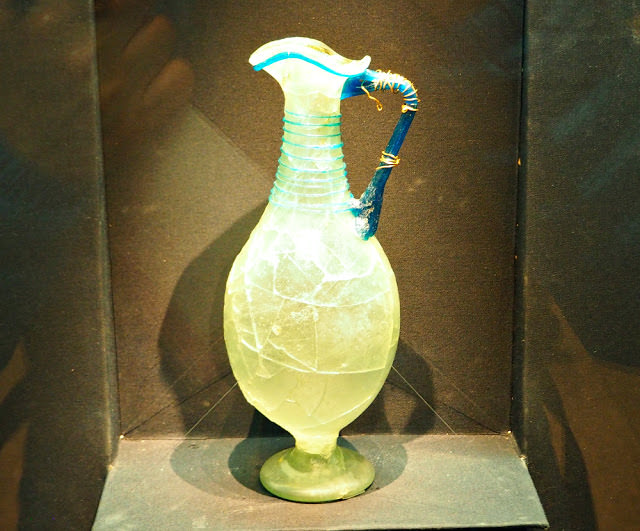 Phoenix-Shaped Glass Vessel
Three-Kingdoms period (Silla), 5th century
Hwangnamdaechong, Gyeongju, Gyeongsang-do
Phoenix-Shaped Glass Vessel
Three-Kingdoms period (Silla), 5th century
Hwangnamdaechong, Gyeongju, Gyeongsang-doOutside Cultural Influences in the Silla Kingdom
There are wooden coffin chamber tombs with stone and earthen mounds of the Silla Kingdom that share structural similarities with those distributed around the Northern regions, including Altai and Pazyryk.
The gold crowns and bell ornaments unearthed from Silla tombs are similar to those of the Northern nomadic cultures.
Some of the excavated burial artifacts, such as glass vessels, inlaid glass beads, and decorated swords, are presumed to have been imported.
The imported goods most probably come over land and sea from as far away as West Asia and the Mediterranean via the Silk Road, attesting to the cosmopolitan character of Silla culture.
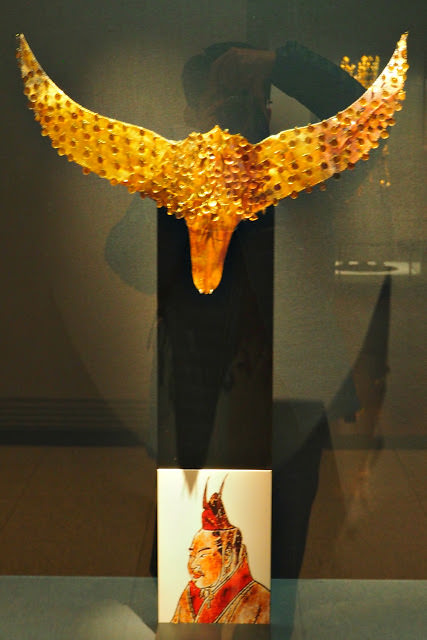 Gold Wings Crown
Gold Wings CrownGolden Wings Crown (above)
This crown, which was usually attached to a gold cap to assemble a kind of crown, is similar in a form outstretched wings of a bird. Each wing is attached with spangles.
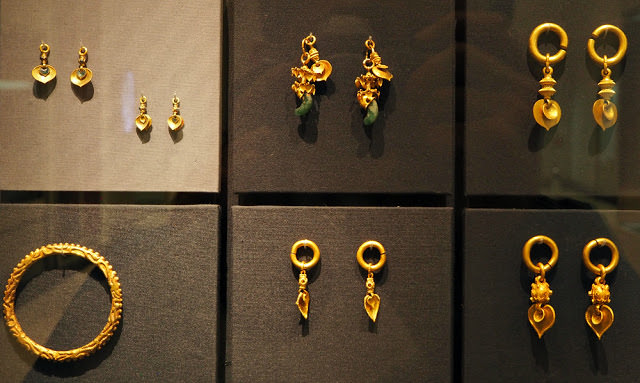 Assorted decorated gold earrings
Assorted decorated gold earrings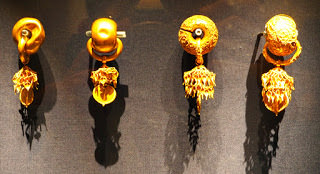 Decorated gold earrings from Silla Period
Decorated gold earrings from Silla Period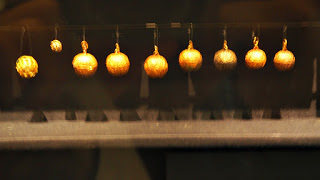 Silla Rounded Gold Earrings
Silla Rounded Gold Earrings Gold Earring Ornaments
At the Bomundong Double Burial in Gyeongju and the ones in Geumjochong Tomb in Yangsan excavations feature thick and hollow rings decorated with filigree, decorative metalwork with tiny gold or silver beads securely soldered to the face of an ornamented object of similar material.
The main rings are specially decorated with lots of gold grains arranged in the tortoiseshell and floral motifs, which make them the finest of all the ear ornaments discovered in Silla burials.
The earrings in the Korean Peninsula, are classified into two kinds, according to the thickness or thinness of the central hollow ring.
It is believed that earrings with a thick hollow ring were fixed to the ear with leather string.
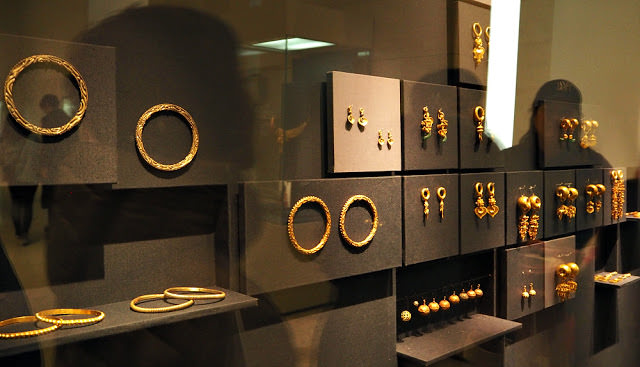 Silla Kingdom's gold accessories including earrings, bracelets, etc.
Silla Kingdom's gold accessories including earrings, bracelets, etc.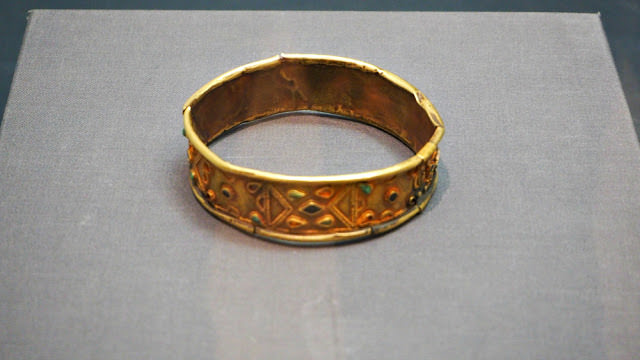 Decorated Gold Bracelet
Decorated Gold BraceletJewelry items of Silla Kingdom, such as gold crowns, crown ornaments, inner caps, earrings, necklaces, bracelets, rings, belt ornaments, and shoes, amaze viewers with their various materials and shapes.
Some accessories and other items were made of glass or crystal, but gold was by far the most common material. Such adornments were also symbolic of social and political authority.
Getting to the NMOK & Gyeongju City
You can see more about the story and artifacts of Silla Kingdom at South Korea's national museum. Yes, they are exciting and entertaining as well as educational. They are indeed worth your time and resources.
The museum is enormous and houses thousands of ancient artifacts, both donated and excavated after many decades of work and research.
You can check out more about the National Museum of Korea here and see how to get there using public transports. It is in Seoul, so it is quite easy to find.
Also, click Getting To Gyeojgu City to learn how to reach the old and former capital of Silla Kingdom.
I hope this is helpful in your search for the story and artifacts of Silla Kingdom in ancient Korea.
Have a fantastic day!
- Home
- Historical Attractions
- Silla Kingdom
Get Exciting Activities
Book one of our exciting activities today to experience the thrill of a lifetime! Take advantage of this opportunity and secure your spot in advance.
Hotel Map Guide
Find your affordable, accessible, and comfortable hotel in Seoul at Agoda.Com. See the hotel map below...
Hotel Booking Guide
Find affordable and amazing hotels on Agoda.com using the search box below. Book now to enjoy great discounts and save!
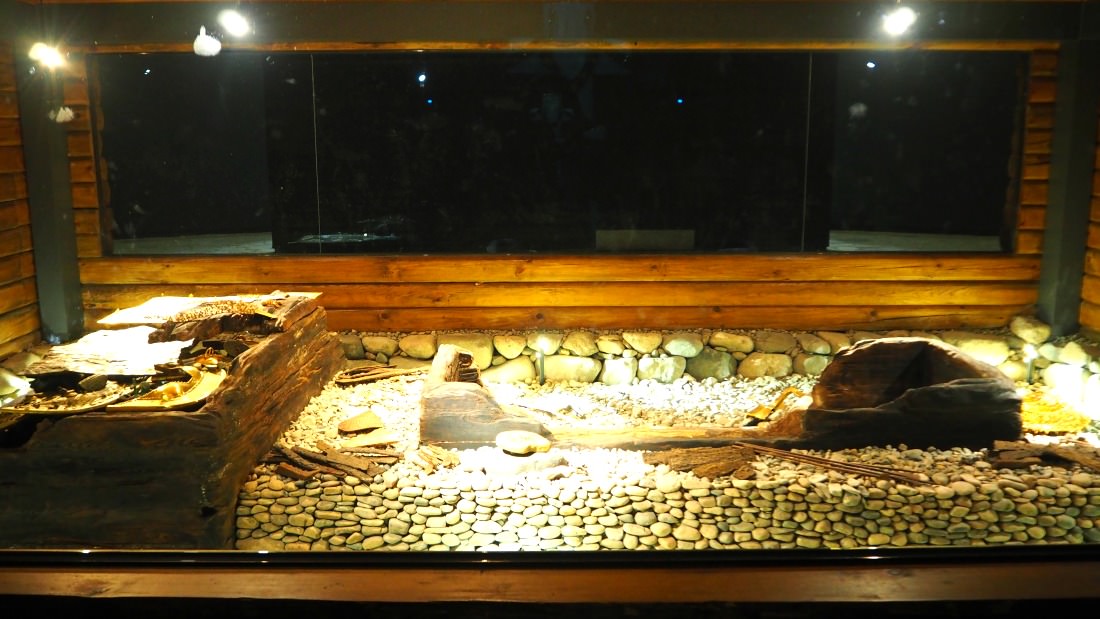
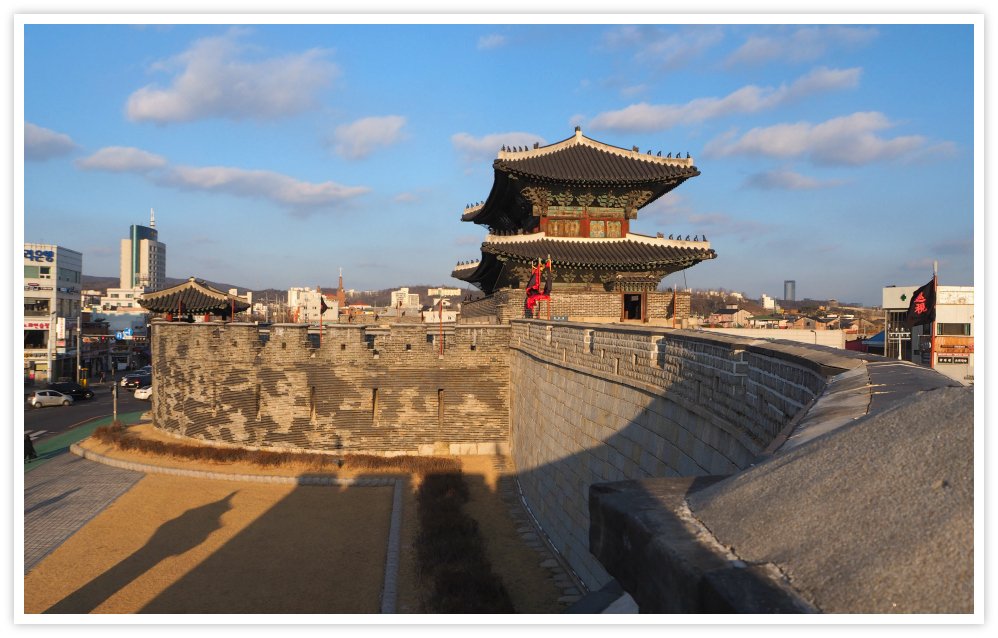

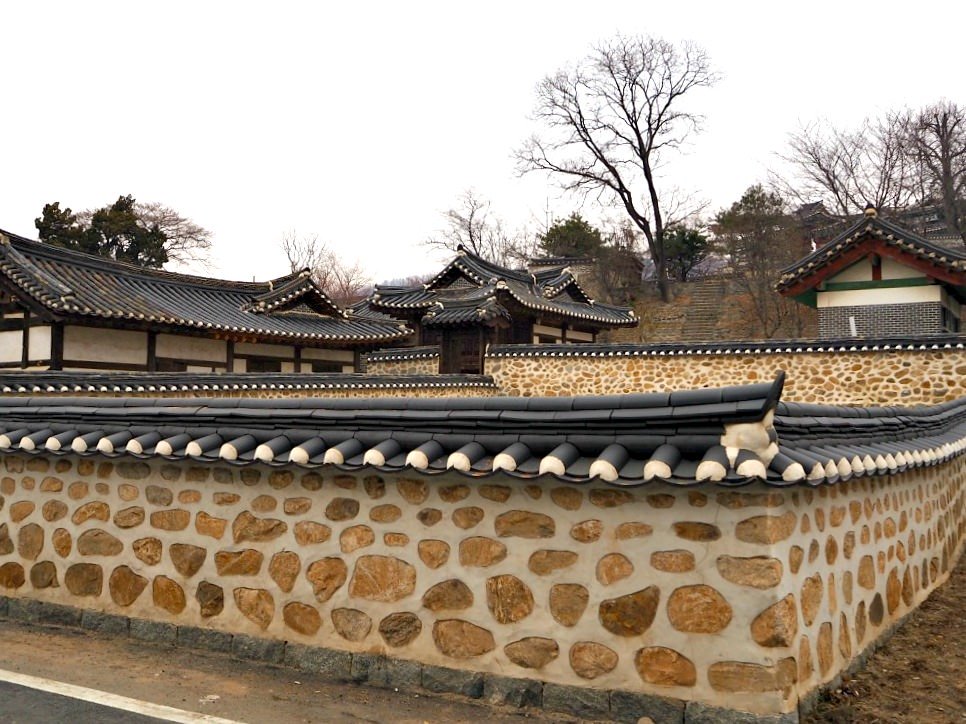




New! Comments
What do you think about this page? Leave me a comment in the box below.